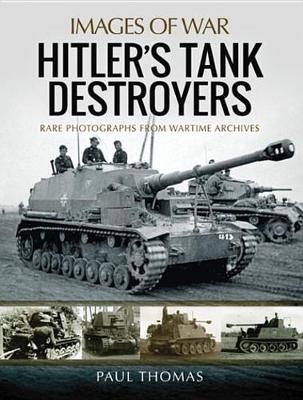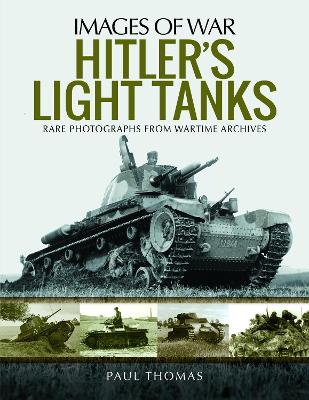Images of War
7 total works
Hitler's Light Panzers at War is a highly illustrated record of the German light tank from its beginnings in the 1930s to the key battles it fought in Poland, France, North Africa, Russia and North Western Europe. The book analyses the development of the light Panzer, which ranged from the Panzer I, II and the Czech build Panzer 35 & 38t. It describes how the Germans carefully utilized the development of these light machines for war, and depicts how these tanks were adapted and up-gunned to face the ever-increasing enemy threat. Using 250 rare and unpublished photographs together with detailed captions and accompanying text, Hitler's Light Panzers At War provides a unique insight into the many variants that saw action on the battlefield. It provides a vivid account of light Panzer operational deployment from the early Blitzkrieg campaigns to the final demise of the Nazi war machine.
Dedicated German anti-tank vehicles made their first major appearance in the Second World War as combatants developed effective armoured vehicles and tactics. Some were little more than stopgap solutions, mounting an anti-tank gun on a tracked vehicle to give mobility, while others were more sophisticated designs. The book covers the development and technology throughout the war that led to tank destroyers like the Panzerjger I, Sturmgeschtz, Marders, Nashorn. Hetzer, Jagdpanzer, Elefant, Jagdtiger IV and Jagdpanther vehicles being developed. As the war progressed the tank destroyers fire power became more lethal to meet the ever increasing threat against Soviet armour. Larger and more powerful variants entered the battlefield, but due the overwhelming enemy opposition they were compelled not only to attack armour, but to support ground troops too. This comprehensive account covers all the Nazis mobile anti-tank vehicles in words and images.
In the aftermath of The Great War, which saw the revolutionary introduction of the Tank, the more far-sighted military leaders of the major powers understood that the future of warfare hinged on a balance of mobility, firepower and protection. The Wehrmacht, in particular, realised that tanks would need to be accompanied into battle by supporting arms, specifically infantry, artillery and engineers. As a fully-tracked field army would be too expensive, semi-tracked support vehicles (commonly called half-tracks) were born. The Germans commissioned numerous types of half-tracked tractors, which were classified by the weight of their towed load and designated Sonderkraffarzeug (special motorized vehicle), abbreviated to Sd.Kfz. These front-wheel steering vehicles with tracked drive transformed the fighting quality of the armoured divisions making it possible for the infantry, artillery and engineers to keep up with the speed of the Panzers' advance. The half-track even became the preferred reconnaissance vehicle.This latest addition to the highly successful and collectable Images of War series has a superb collection of rare images, supported by detailed captions and text, of the many Sd.
Kfz variants in diverse theatres of war. It is worth reflecting that, without half-tracks, there could have been no Blitzkrieg.
Kfz variants in diverse theatres of war. It is worth reflecting that, without half-tracks, there could have been no Blitzkrieg.
Hitler's Wehrmacht led the way in armoured warfare as the successful blitzkriegs in Poland and North West Europe in 1940 so convincingly proved. The contribution of light tanks such as Panzers I, II and 35(t) was critical.
As the war spread to the Balkans, north Africa and the invasion of Russia, German engineers worked tirelessly modifying existing light tanks and developing new models. The growing Soviet armoured threat, in particular, spawned tank destroyers such as the Marder III Panzerjager, SdKfz 138/1 and 139. Anti-aircraft variants included the Flakpanzer 38(t) and the SdKfz 140/1 was a reconnaissance tank armed with a 20mm turret-mounted gun, developed from the SdKfz 22 armoured car, whereas the Aufklarungerspanzer 38(t) carried a 7.5cm gun in the support reconnaissance role.
In the final stages of the war light tanks were phased out and the Marder and 38 (t) were up-gunned; the Wespe was adapted from the Panzer II chassis.
This superbly illustrated book gives a comprehensive overview of the multitude of vehicles and variants that came into service. With the text and captions providing technical data, the images show this formidable array of fighting vehicles in action across the theatres of war.
As the war spread to the Balkans, north Africa and the invasion of Russia, German engineers worked tirelessly modifying existing light tanks and developing new models. The growing Soviet armoured threat, in particular, spawned tank destroyers such as the Marder III Panzerjager, SdKfz 138/1 and 139. Anti-aircraft variants included the Flakpanzer 38(t) and the SdKfz 140/1 was a reconnaissance tank armed with a 20mm turret-mounted gun, developed from the SdKfz 22 armoured car, whereas the Aufklarungerspanzer 38(t) carried a 7.5cm gun in the support reconnaissance role.
In the final stages of the war light tanks were phased out and the Marder and 38 (t) were up-gunned; the Wespe was adapted from the Panzer II chassis.
This superbly illustrated book gives a comprehensive overview of the multitude of vehicles and variants that came into service. With the text and captions providing technical data, the images show this formidable array of fighting vehicles in action across the theatres of war.


